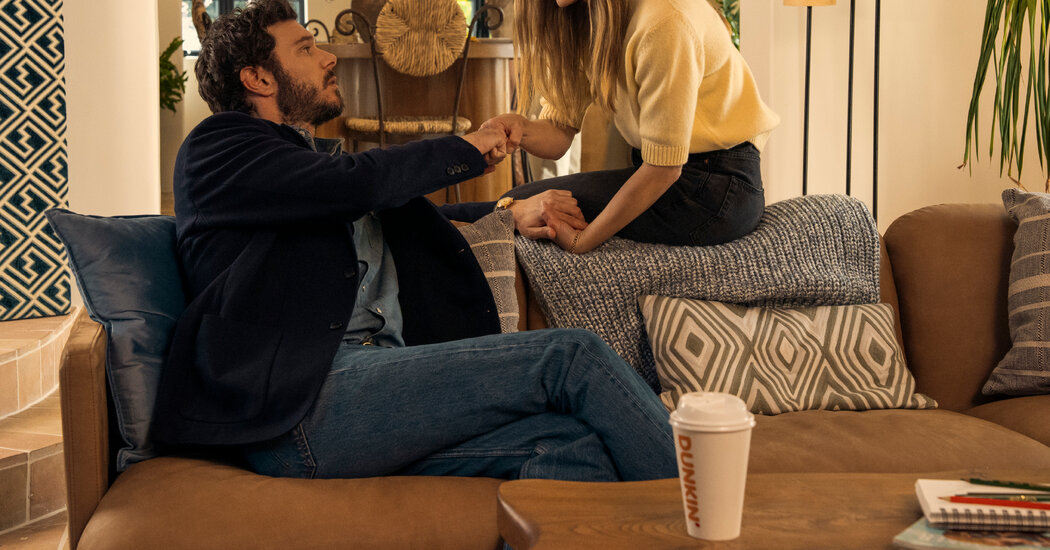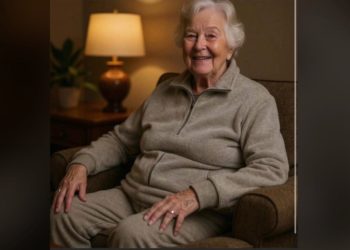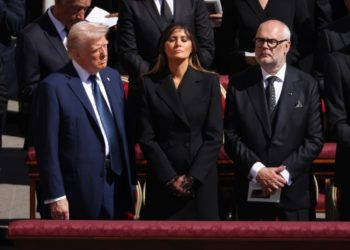Midway through Season 2 of the popular Netflix rom-com series “Nobody Wants This,” which began streaming last week, the show’s main character, a podcast host named Joanne (Kristen Bell), attends a baby naming ceremony that is being officiated by her rabbi boyfriend, Noah (Adam Brody).
As the party unfolds and guests mingle, Joanne sneaks upstairs into a bathroom to call her sister, Morgan (Justine Lupe). While on the phone, Joanne snoops through the toiletries, finds an Estée Lauder face serum and inexplicably decides to put some on her face. The camera zooms in on the bottle.
On Reddit and TikTok, viewers picked that scene apart. Why was she applying serum on top of her makeup? And why, if this was a product placement, would they showcase a night serum for a daytime scene? On LinkedIn, one user described the moment as “diabolical.”
The scene was not the only one in Season 2 that featured what appeared to be overt product placement.
Joanne is often seen holding a Dunkin’ cup angled so that its branding can be seen. A Jennifer Meyer necklace plays a pivotal role on Valentine’s Day, and is mentioned by name. There’s a steamy scene featuring a sweatshirt by the Sichuan chili oil company Fly by Jing. There’s a whole AirBnB experience.
All of which raises the very 2025 question: When does a show starts feeling less like a show and more like an ad?
“When it’s really overt, you, as the viewer, feel disrupted,” said Erin Schmidt, the manager of product placement at BENLabs, a marketing agency that has been helping brands appear in TV and movies for 40 years. “The reason that we’ve opted into streaming, the reason we spend money to have no ads, is that we got tired of the disruptive experience. So when you turn a placement into an advertisement, you’re disrupting the viewer experience again.”
Brands have long sought to place their products in pivotal movie scenes or TV shows, Ms. Schmidt said, and, in return, the money helps fund the creative side of the project. For example, BENLabs worked to place a few branded products in the Netflix show “Never Have I Ever,” and Ms. Schmidt said the money was used by the producers to license music for the series.
In Season 1 of “Nobody Wants This,” BENLabs worked with the show’s production team to pull off a more subtle product placement: Noah driving a Cadillac. Ms. Schmidt said product placement in a show’s first season often feels more authentic because there are fewer brands wanting to cash in. But when the show starts to gain traction, brands want in — often in more obvious ways.
“It’s no longer an organic experience,” she said, adding, “maybe there’s more verbal mentions or it’s more blatantly in your face.”
At least some of the product placements on the second season of “Nobody Wants This” were organic. The actress Sherry Cola, who plays Joanne’s podcast producer, Ashley, is friends with Jing Gao, the founder of Fly by Jing, and she was wearing the brand’s blue, bold sweatshirt on set when it caught Ms. Bell’s attention, Ms. Gao said in an interview.
“It was actually Kristen Bell’s idea to style herself” in that scene, she said.
“The next thing I know, someone on the team had reached out just to let us know,” Ms. Gao added. “But they didn’t ask for any product or anything like that.”
The Fly by Jing team had no insight into what the scene would entail or how visible their merchandise would be. But in anticipation of its release, they restocked the sold-out sweatshirts that had previously been spotted on notable people like Tan France and Sabina Gadecki-Rich.
Within 48 hours of the season’s premiere, the sweatshirts were sold out again, Ms. Gao said.
Similarly, Jennifer Meyer is friends Erin and Sara Foster, the sisters who created and produced the show. The show reached out to Ms. Meyer to ask for two necklaces engraved with the names “Joanne” and “Rebecca.” It was not a paid-for placement, Ms. Meyer said in an interview.
“I have never done paid product placement in my life — not for a red carpet, not for a show, not for anything,” she said. “I have a small business and that’s just not the business that I’m in or the business that I can afford to be in.”
Affordability plays a big role in which products are placed in shows and movies, Ms. Schmidt said, because it can oftentimes cost millions of dollars, depending on how much the brand is shown and the prominence of the TV show or movie. Sometimes, brands will demand editorial control of how they are portrayed, she added, or they will offer certain direction around their products.
“When producers work with General Motors, for example, you have to wear a seatbelt, there can’t be drunk driving,” she said.
The production company behind “Nobody Wants This,” 20th Television, did not respond to a request for comment, but to many viewers, the product placement was off putting, with many online suggesting that regular commercial breaks might have been preferable.
“It just honestly took away from the experience,” said Michael Fundora, who posted a video on TikTok parodying all the products in the show.
Alisha Haridasani Gupta is a Times reporter covering women’s health and health inequities.
The post Nobody Wants This (Product Placement) appeared first on New York Times.




